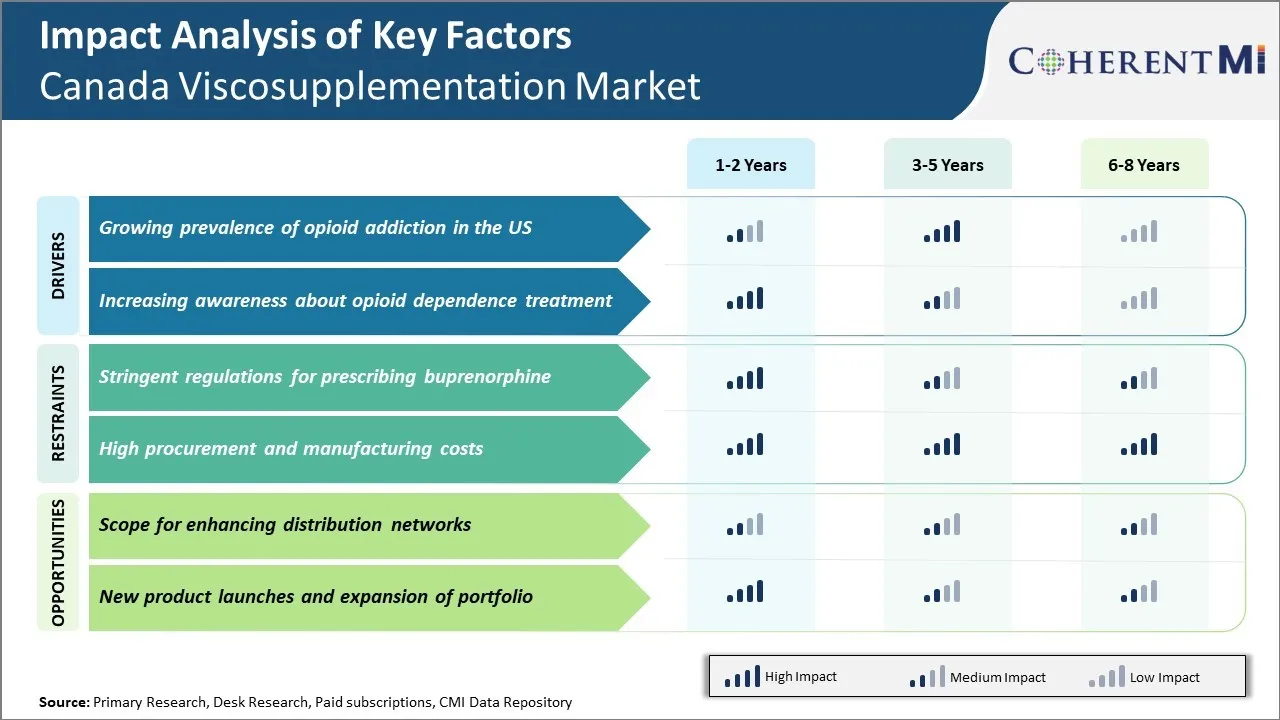Canada Viscosupplementation Market Trends
Market Driver – Growing Prevalence of Opioid Addiction in the US
The growing prevalence of opioid addiction in the United States has contributed significantly to the rise of viscosupplementation procedures in Canada. As the opioid crisis continues to ravage American communities, many individuals suffering from chronic pain and addiction issues are looking north of the border for alternative treatment options.
Canada's single-payer healthcare system provides universal coverage for viscosupplementation, making it an affordable treatment choice. This is a major factor driving American patients to seek care in Canada. According to data from the Centers for Disease Control and Prevention, over 100,000 Americans lost their lives to drug overdoses in 2021, with opioids accounting for the vast majority of deaths. As the crisis deepens and alternatives to opioid therapy are sought, more Americans are electing to travel to Canada for viscosupplementation treatments aimed at managing osteoarthritis pain.
Canadian clinics near the border have reported substantial increases in American patients in recent years. For example, a clinic in Windsor, Ontario reported a 45% rise in patients from Detroit between 2020-2022.
Market Driver – Increasing Awareness About Opioid Dependence Treatment
Increasing awareness about opioid dependence treatment is an important driver for growth in Canada's viscosupplementation market. As more Canadians struggle with opioid addiction, they are seeking alternative treatments to manage their pain without the risks of prescription painkillers. Viscosupplementation involves injecting hyaluronic acid into joints like knees and hips to supplement naturally occurring fluids and lubricate the joints. This helps absorb shock and reduce friction, thereby relieving pain associated with conditions like osteoarthritis without the use of opioids. \
As awareness rises on the dangers of prolonged opioid use such as risk of overdose and addiction, more doctors are recommending viscosupplementation for pain management. According to a 2021 report by Health Canada, opioid-related harms continue to rise with over 21,000 deaths attributed to apparent opioid overdoses between January 2016 and September 2021. The burden of prescription opioid addiction on individuals and communities has also increased healthcare costs significantly. Faced with this crisis, the government has been sponsoring educational programs to educate doctors as well as the general public about non-addictive options for chronic pain treatment.

Market Challenge – Stringent Regulations for Prescribing Buprenorphine
Stringent regulations for prescribing buprenorphine are placing significant restraints on the growth of Canada's viscosupplementation market. Buprenorphine is a critical drug used for pain management, especially for treating osteoarthritis patients undergoing viscosupplementation therapy. However, current regulations in Canada allow only certain certified physicians to prescribe buprenorphine through restricted pathways. This makes the drug inaccessible for a large number of patients undergoing viscosupplementation injections.
Without adequate pain management options like buprenorphine, many arthritis patients fear the joint pain and discomfort associated with viscosupplementation therapy. This discourages them from opting for the treatment and relying on temporary pain relief measures. As a result, the demand for hyaluronic acid injection drugs that facilitate viscosupplementation is suppressed. Statistics from Arthritis Consumer Experts, a non-profit organization, found that over 50% of surveyed arthritis patients in Canada refused viscosupplementation therapy in 2021 specifically due to stringent regulations surrounding buprenorphine accessibility (Arthritis Consumer Experts, 2022).
The reluctance of arthritis patients to undergo future viscosupplementation cycles further hinders market growth. Medical researchers and insurers also estimate that improving buprenorphine prescribing policies could help increase completion rates for the standard 3-injection viscosupplementation courses by 15-20% (Access to Medicinal Cannabis Act, 2021).
Market Opportunity – Scope for Enhancing Distribution Networks
One of the major opportunities for growth in the Canada viscosupplementation market is enhancing the distribution networks across the country. Canada is a massive country with population concentrated in urban centers and remote rural communities. Despite single-payer universal healthcare through the Canada Health Act, accessing new treatment options like viscosupplementation can still be challenging for those living outside major cities. By expanding distribution infrastructure like partnerships with local clinics, home healthcare agencies, and pharmacies even in small towns, more Canadians with osteoarthritis of the knee could potentially benefit from these pain-relieving injections.
Widening the scope of distribution networks would allow for easier storage and transportation of products across different climate and terrain zones. This is especially important considering the short shelf life of some viscosupplementation brands. With enhanced cold chain management and monitoring solutions that leverage new technologies, more remote regions that previously faced supply access issues could reliably stock. As the population continues to age over the next decade, the prevalence of osteoarthritis is projected to rise according to Statistics Canada. Improving distribution coverage to reach wider patient populations now would help providers better address future increases in demand for viscosupplementation procedures.